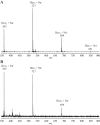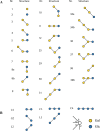Kinetics and products of Thermotoga maritima β-glucosidase with lactose and cellobiose
- PMID: 38809317
- PMCID: PMC11136819
- DOI: 10.1007/s00253-024-13183-6
Kinetics and products of Thermotoga maritima β-glucosidase with lactose and cellobiose
Abstract
Galacto-oligosaccharides (GOS) are prebiotic compounds that are mainly used in infant formula to mimic bifidogenic effects of mother's milk. They are synthesized by β-galactosidase enzymes in a trans-glycosylation reaction with lactose. Many β-galactosidase enzymes from different sources have been studied, resulting in varying GOS product compositions and yields. The in vivo role of these enzymes is in lactose hydrolysis. Therefore, the best GOS yields were achieved at high lactose concentrations up to 60%wt, which require a relatively high temperature to dissolve. Some thermostable β-glucosidase enzymes from thermophilic bacteria are also capable of using lactose or para nitrophenyl-galactose as a substrate. Here, we describe the use of the β-glucosidase BglA from Thermotoga maritima for synthesis of oligosaccharides derived from lactose and cellobiose and their detailed structural characterization. Also, the BglA enzyme kinetics and yields were determined, showing highest productivity at higher lactose and cellobiose concentrations. The BglA trans-glycosylation/hydrolysis ratio was higher with 57%wt lactose than with a nearly saturated cellobiose (20%wt) solution. The yield of GOS was very high, reaching 72.1%wt GOS from lactose. Structural elucidation of the products showed mainly β(1 → 3) and β(1 → 6) elongating activity, but also some β(1 → 4) elongation was observed. The β-glucosidase BglA from T. maritima was shown to be a very versatile enzyme, producing high yields of oligosaccharides, particularly GOS from lactose. KEY POINTS: • β-Glucosidase of Thermotoga maritima synthesizes GOS from lactose at very high yield. • Thermotoga maritima β-glucosidase has high activity and high thermostability. • Thermotoga maritima β-glucosidase GOS contains mainly (β1-3) and (β1-6) linkages.
Keywords: Galacto-oligosaccharides; Galactosidase; Gluco-oligosaccharides; Glucosidase; Thermostable.
© 2024. The Author(s).
Conflict of interest statement
Geralt A. ten Kate is currently employed by FrieslandCampina. The company had no participation in the study or any influence on the contents of this paper.
Peter Sanders declares no conflict of interest.
Sander S. van Leeuwen declares no conflict of interest.
Lubbert Dijkhuizen is currently employed at Carbexplore Research BV, a company that produces and markets β-galactosidase enzymes and their reaction products. The company had no participation in the study or any influence on the contents of the article.
Figures






References
-
- Alizadeh A, Akbari P, Difilippo E, Schols HA, Ulfman LH, Schoterman MHC, Garssen J, Fink-Gremmels J, Braber S (2016) The piglet as a model for studying dietary components in infant diets: effects of galacto-oligosaccharides on intestinal functions. Brit J Nutr 115:605–618. 10.1017/S0007114515004997 - PubMed
-
- Alnadari F, Xue Y, Almakas A, Mohedein A, Samie A, Abdel‐Shafi M, Abdin M (2021) Large batch production of galactooligosaccharides using β‐glucosidase immobilized on chitosan‐functionalized magnetic nanoparticle. J Food Biochem 45. 10.1111/jfbc.13589 - PubMed
-
- Arreola SL, Intanon M, Suljic J, Kittl R, Pham NH, Kosma P, Haltrich D, Nguyen TH (2014) Two β-galactosidases from the human isolate Bifidobacterium breve DSM 20213: Molecular cloning and expression, biochemical characterization and synthesis of galacto-oligosaccharides. PLoS One 9. 10.1371/journal.pone.0104056 - PMC - PubMed
-
- Benjamins E, Boxem L, KleinJan-Noeverman J, Broekhuis TA (2014) Assessment of repetitive batch-wise synthesis of galacto-oligosaccharides from lactose slurry using immobilised β-galactosidase from Bacillus circulans. Int Dairy J 38:160–168. 10.1016/j.idairyj.2014.03.011
-
- Bindels LB, Delzenne NM, Cani PD, Walter J (2015) Towards a more comprehensive concept for prebiotics. Nat Rev Gastroenterol Hepatol 12:303–310. 10.1038/nrgastro.2015.47 - PubMed
MeSH terms
Substances
LinkOut - more resources
Full Text Sources
Molecular Biology Databases

